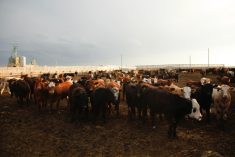Compared to last week, western Canadian feeder cattle traded $8-$10 lower while U.S. prices were also down $5-$10 from week-ago levels.
The feeder market appeared to short-circuit after I thought the market was charged to move higher in last week’s report. Feedlot operators and cattle feeders saturated their demand prior to the New Year and we now find the market contending with subdued buying interest. Extremely cold temperatures, which plagued much of the Prairies, also caused the market to incorporated a risk discount. Feedlot margins remain in positive territory but weakness in fed cattle prices early in the week also put buyers on the defensive. Heavier replacements took the brunt of the decline while quality packages of pre-conditioned calves experienced minimal price deterioration. Eastern Saskatchewan and Manitoba markets that were red-hot in December fizzled out trading on par with major Alberta markets.
Read Also

U.S. grains: Wheat futures rise on supply snags in top-exporter Russia
U.S. wheat futures closed higher on Thursday on concerns over the limited availability of supplies for export in Russia, analysts said.
In central Saskatchewan, medium- to larger-frame black steers weighing 860 lbs. traded for $190 while similar-quality heifers averaging 800 lbs. were quoted at $170. In central Alberta 890-lb. mixed tan steers traded for $188 while run-of-the-mill mixed heifers weighing 860 lbs. were quoted at $175.
Calf markets appeared to fizzle out after the boiling period three weeks ago. Black Angus-based steers weighing 560 lbs. traded for $226 in east-central Saskatchewan; tan semi-weaned steers weighing 550 lbs. were quoted at $228 south of Edmonton.
Alberta fed cattle prices softened earlier in the week but by Friday, active trade was similar to seven days earlier. The volatility in the fed cattle market made feedlot operators realize how vulnerable the market and there appears to be a limit how far western Canadian feeder cattle prices can divorce from the U.S. market.
— Jerry Klassen manages the Canadian office of Swiss-based grain trader GAP SA Grains and Produits Ltd. and is president and founder of Resilient Capital, specializing in proprietary commodity futures trading and market analysis. Jerry consults with feedlots on risk management and writes a weekly cattle market commentary. He can be reached at 204-504-8339.















